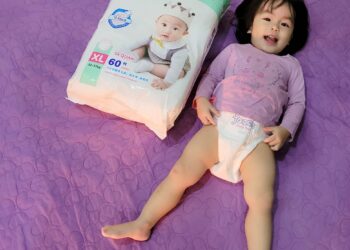Diaper rash in newborns is a concern for many parents seeking to protect their little one’s delicate and sensitive skin during seasonal transitions. Although diaper rash might quietly creep in, it’s enough to make a mother’s beloved child “lose appetite and sleep” for several days. It not only causes the baby’s skin to swell, redden, and itch but also leads to fussiness, reduced appetite, and weight loss.
Here are some essential insights that mothers should equip themselves with to prevent diaper rash in newborns and handle it in the safest manner possible.
The Causes of Diaper Rash in newborns
Busy lives often lead parents to unintentionally neglect changing diapers frequently, sometimes leaving them on for too long, even overnight, resulting in prolonged moisture on the baby’s skin, lack of air circulation, and a breeding ground for bacteria and fungi. The tender skin of the baby also frequently comes into contact with enzymes present in stool and urine.

Diaper rash can also stem from hurriedly wrapping the diaper around the baby without properly drying the skin after bathing, allowing bacteria to invade.
Tight or low-quality diapers that rub harshly against the skin cause more abrasions, leading to more frequent occurrences of diaper rash. Even using cloth diapers can make a sensitive baby’s skin prone to diaper rash due to reactions with chemicals in detergents and fabric softeners.
An apparently unrelated factor contributing to diaper rash in newborns is bottle-feeding, which tends to cause more diaper rashes compared to breastfeeding. Breast milk provides exactly what the baby needs more effectively, reducing the risk of diaper rash due to fewer irritating enzymes affecting the skin.
Symptoms of Diaper Rash in Newborns
The baby’s skin becomes swollen, red, and irritated in the diaper area, especially around the buttocks, groin, thighs, and abdomen. Diaper rash in newborns presents in various degrees, ranging from mild to severe. Alongside the signs of swelling, redness, additional symptoms such as itching, soreness, increased fussiness, reduced appetite, and challenging care routines might occur.
While diaper rash isn’t inherently dangerous, it can cause extreme discomfort for the child. If left untreated for an extended period, it can lead to severe skin damage, causing skin inflammation, infection, and potentially other illnesses.
5 Safe Natural Remedies for Diaper rash in newborns
-
Coconut oil
With its antifungal and antibacterial properties, coconut oil is a widely-used natural remedy for diaper rash. To treat diaper rash in newborns with coconut oil, simply apply a thin layer to the affected area to soothe and moisturize the skin. Prior to application, ensure clean hands and opt for pure coconut oil for best results.
-
Breast Milk
Breast milk is an effective and cost-efficient way to treat diaper rash. It contains natural antibiotics that help kill bacteria and cleanse the skin, thereby reducing diaper rash symptoms. Apply a few drops of breast milk to the affected area and allow it to air dry before putting on a new diaper.
-
Vinegar solution
Urine is alkaline, and prolonged exposure without changing diapers can lead to irritation and diaper rash. To counter this, you can use vinegar to neutralize and balance the pH levels. To treat diaper rash with vinegar, mix half a cup of vinegar with half a bucket of water and soak the baby’s cloth diapers in this solution. Additionally, you can mix a teaspoon of white vinegar in water and use this solution to clean the baby’s skin during diaper changes.
-
Aloe vera
Aloe vera possesses anti-inflammatory properties and is rich in vitamin E, making it an effective remedy for treating diaper rash in newborns. Simply cut a thin slice of aloe vera leaf and apply it to the affected area, allowing it to dry naturally before putting on a diaper. However, ensure you purchase aloe vera from reputable sources without pesticides or preservatives to avoid harming the baby’s skin.
-
Tea tree essential oil
Known for its antiseptic and antibacterial properties, tea tree oil is an effective remedy for diaper rash. Mix 3 drops of tea tree oil with a carrier oil and gently apply it to the affected diaper area. After a few days, you’ll likely notice significant healing in the irritated skin.
Cautions in Treating Diaper Rash in Newborns
Diaper rash is a fairly common issue in newborns, and treating it isn’t overly complicated. However, when caring for and treating diaper rash in infants, it’s important to note the following to prevent worsening symptoms:
- Avoid hastily using baby powder or cornstarch to treat diaper rash as these powders might irritate your baby’s sensitive skin, slow down the healing process, and potentially foster yeast growth.
- Refrain from using scented products for cleaning your baby as the fragrances from these products can cause irritation and exacerbate diaper rash symptoms.
- Avoid using wet wipes containing propylene glycol for cleaning as it can cause irritation and spread bacteria.
- Refrain from self-administering antifungal medications meant for adults on your baby’s skin. Before using any medication on your baby, it’s advisable to seek advice from a doctor.
Preventing diaper rash in newborns
Diaper rash isn’t a dangerous condition and doesn’t pose significant health issues, but it can cause discomfort and pain for babies. As a parent, you can help reduce the likelihood of this issue through the following measures:
Changing diapers frequently
Changing diapers every one to two hours is a preventive measure and treatment for diaper rash in newborns. The rationale is that when stool and urine are left in contact with the skin, bacteria multiply rapidly. Prolonged exposure to these conditions can lead to diaper rash and skin irritation.
Using clean warm water for diaper area hygiene
When cleaning the diaper area, to avoid irritation, use warm water and a gentle cloth. If the baby is particularly soiled, you can use a mild, unscented soap. After cleaning, ensure the area is completely dry before putting on a new diaper.
Giving babies “naked time” during the day
Instead of constantly keeping the baby in diapers, allow some ‘naked time.’ This not only helps keep the diaper area dry but also reduces discomfort caused by the friction of the diaper against irritated skin. To minimize the risk of accidents, you can place a waterproof pad on the bed before laying the baby down”.
Changing diaper brands if irritation occurs
If you notice your baby experiencing diaper rash, consider switching to a different diaper brand. It’s possible that the current brand might be prone to leakage or contain fragrances that could cause irritation, especially for babies with highly sensitive skin. When selecting diapers for your baby, opt for sizes that fit properly to avoid discomfort, tightness, or chafing that could lead to diaper rash.
Using protective and preventative Diaper Cream
Diaper cream stands out as one of the most common preventive and treatment measures for diaper rash that most parents consider. There are numerous types of diaper rash creams available in the market, each with varying ingredients. However, many contain zinc oxide along with natural elements to soothe the skin. If your baby frequently experiences diaper rash, you might consider using these products as a preventive measure to avoid diaper rash altogether.
What Should Mothers Do to Limit Baby Diaper Rash?
Keep the baby dry by changing diapers frequently. For newborns in their first months, change diapers every 2-3 hours. Whenever the baby passes stool, change immediately to prevent bacterial growth. Babies tend to sweat during playful activities, and even if the diaper isn’t full, changing it every 4 hours can prevent discomfort and itching.
Clean the diaper area with clean warm, water or alcohol-free, paraben-free wet wipes, then pat dry gently with a soft cloth before putting on a new diaper to prevent diaper rash.
Ensure clean hands using natural, safe hand sanitizers before touching the baby’s skin. Allow the baby some ‘nude time’ for a few hours daily to let the skin breathe and stay dry.
Mothers need to select soft, thin diapers to avoid friction on the baby’s sensitive skin. Jo diapers are designed to be super thin, maximizing absorption while providing comfort, especially during prolonged wear or hot weather. Its cotton-like surface cares for the baby’s delicate skin like a mother’s touch. Furthermore, the nano silver molecules in Jo diapers eliminate viruses and bacteria, maintaining a clean, breathable environment and protecting the baby’s skin from diaper rash.

When the baby already has diaper rash, mothers should minimize the use of diapers as much as possible. If diaper rash persists or worsens after a few days despite these measures, seek medical advice.
Your beloved babies needs more than what they can express. Therefore, mothers should understand their baby’s skin needs and choose medically certified, skin-safe products. Childhood is a precious time, so offer your child the best care and attention, dear mothers!






